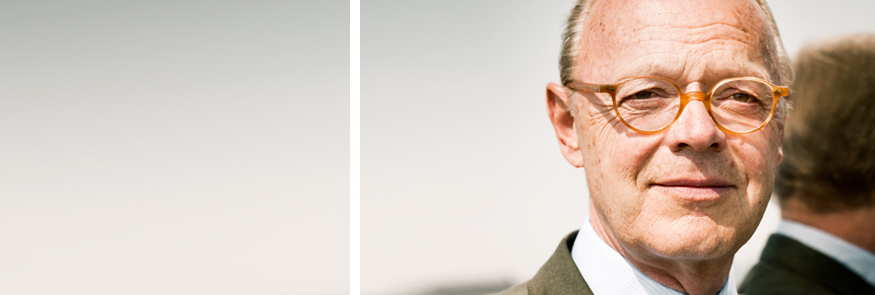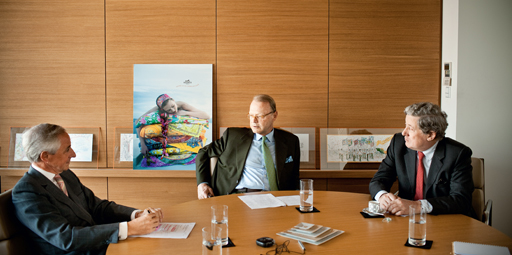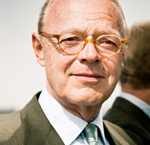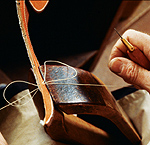“Our good fortune is being able to live values that are lasting and universal.”
Patrick Thomas on creativity, team spirit, and the pursuit of perfection at Hermès International

The cradle of Hermès International is not Paris, where the company is now based, but Krefeld in Germany, once a center of the silk and satin trade. This was where, in 1801, Thierry Hermès was born into a family of French Protestant refugees. Orphaned by the Napoleonic wars, Hermès moved to France, where he became a master saddler and opened his own business in 1837. Two generations later, as cars gradually took the place of horse-drawn carriages in the early 20th century, his grandson began to specialize in travel bags and cases. In terms of both its founder’s biography and its corporate history, Hermès can be considered a model of resilience. In crisis year 2009 the luxury goods group proved a tower of strength. Patrick Thomas has been CEO of Hermès since the beginning of 2006. He talked to THE FOCUS about what makes the company so crisisproof.
TRUE, HERMÈS INTERNATIONAL is a leading exponent of the art of understatement, but the answer provided by Patrick Thomas (61) nevertheless takes us by surprise. The first non-family CEO of this family firm of luxury goods manufacturers is in his office on the top floor of company headquarters, with a magnificent view over Paris. Asked why Hermès proved more resistant to the crisis than many other companies, he says simply, “There’s always a measure of chance and good fortune involved.” Let other corporate leaders attribute their company’s resilience to brilliant crisis management, Thomas is having none of it: “Our good fortune,” he explains, “is to have a value-based business model that is focused on the permanent pursuit of higher quality. That is the way things have been for six generations now, ever since the company was founded 173 years ago.” In 1837 Thierry Hermès, the son of Protestant refugees, opened a saddler’s workshop in Paris. “And from the outset,” says Thomas, “there has only ever been one goal, and that is perfection.”
Ever since those early years, he adds, all subsequent chief executives and managers have aligned their activities with that goal: “Our values are deeply embedded, enduring, and universal. Our operations in China, the U.S., Japan, and Europe all share them with us. Values are not something one changes from one day to the next. In some cases they must never be changed at all. To give you a simple analogy: without egg-yolk and oil, a delicacy like hand-whipped mayonnaise is not worth eating.”
Thomas recalls with a smile the advice his predecessor, the recently deceased Jean-Louis Dumas, gave him when he handed over the baton: “Please take no decisive action for the next six months.” Thomas took this to heart and spent the next half-year traveling and talking to Hermès people, soaking up the corporate culture. He sums up the experience in what sounds like a simple explanation: “That really helped me to understand the company.” But then comes the decisive rider: “Because without understanding a company you cannot manage it.” And that is perhaps the crucial difference between Patrick Thomas and many other corporate leaders: He sees himself as more of a curator than a revolutionary.
One aspect that Thomas considers particularly worthy of conservation is the shareholder structure at Hermès. This, he says, proved a pillar of strength in the crisis. “Companies with a controlling shareholder have a considerable advantage, and at Hermès the controlling shareholder also happens to be the family who own the firm – and the only shareholder with a seat on the board, which means they can also play an active part in shaping corporate strategy.”
Well-being is a strategic factor
Thomas not only appreciates the sovereign importance of his board, he also voluntarily submits to its rule: “My superior is the board, in the person of its chairman,” he says, providing no little insight into his interpretation of the role of chief executive. There are no false airs and graces here. At the same time he stresses how content he is to be first among equals: “At Hermès, the board will often say ‘Listen, we don’t care what the picture looks like at the end of this year. What counts is where we are in ten years from now,’ and for a chief executive that is an immense relief.” The positive implications are twofold: Firstly, decision-making responsibility rests on several shoulders and not solely with the chief executive, and secondly, such long-term thinking eases the pressure on the chief executive to serve up positive results at short intervals. That kind of approach, Thomas is well aware, is only ever an option for companies like Hermès that have won and retained their financial independence – another decisive factor in making the company crisis-proof.
At least as important as healthy financial reserves, in Patrick Thomas’s view, is keeping the company’s employees motivated and encouraging long-term loyalty – a field in which Hermès is more active than most, he says: “In a family firm like Hermès, the company’s appreciation of its employees is more tangible than elsewhere.” In terms of employee motivation, Thomas has taken a leaf out of his predecessor’s book: “Back in the days when our headquarters were in rue du Faubourg Saint-Honoré,” he relates, “Jean-Louis Dumas would arrive every morning at nine and shake hands with every one of the 300 men and women who worked there. By the time he reached his office on the top floor, it was almost quarter to ten. But in return for the time he invested, he got to know all his people really well, which created an incredible sense of team spirit.”
Thomas too is a great believer in fostering a sense of belonging among his staff. Creating luxury goods is not like other fields of business. “Creativity is the life blood of our company,” he says. “So it’s vital to ensure that our creative people stay motivated. A craftsman who is unhappy in his work will not produce items of such beauty as one who delights in his work. That is why the well-being of our people is anchored in our corporate strategy.” He regularly reminds the members of the Executive Committee, Thomas says, of their duty to ensure a happy workforce. “I personally believe that investing in people promises the best return on investment you could ever hope for.”
Hermès devotes what Thomas calls “a gigantic amount of time” to encouraging its employees to take the company’s mission on board and live its values. Only recently, he recalls, the company organized a workshop where everyone was encouraged to name their unfulfilled dream of a lifetime. Then Hermès set out to help its people get a little closer to making those dreams come true. One group flew to an observatory in Chile to study the night sky. Another group rode through the snow from Moscow to St. Petersburg. Yet another group traveled to Cambodia. And these groups of 15 employees were compiled in such a way that people who had been strangers until then, got to know one another. In this way, Hermès is out to build a sense of team spirit and the company has a long tradition of launching such initiatives. Jean-Louis Dumas, for example, organized a world tour in stages for Hermès employees and currently, Thomas explains, there is an exchange program in place that enables the company’s craftsmen and -women to spend a week at a location where their products are sold. In return, sales staff get to spend a week in the company’s workshops.
The aim of this initiative is to foster an exchange of knowledge, forge stronger emotional ties to the products, and promote creativity, not least among the sales staff – because creativity is pivotal to Hermès success. “It takes creativity to design and manufacture the products and it takes creativity to present them for sale,” says Thomas. “Every one of our 300 retail outlets around the world has a different shopwindow display. Every store manager is free to choose what he or she orders from headquarters and offers our customers. Which makes us a dynamic and unpredictable company. And the more unpredictable you are, the harder you are to imitate.”
A culture of perfection
Hermès invests heavily in creativity, which it considers the heart of the company. The rhythm of everything else is determined by the pulse of a creative team headed up by Artistic Director Pierre-Alexis Dumas, the son of Jean-Louis Dumas. His direct reports include the creative directors of the ten or so departments. In this respect, Thomas explains, Hermès has deliberately opted for a dual structure, with a commercial manager ranked equally alongside a creative director in each department. This structure, says Thomas, reflects the company’s pursuit of excellence in all things. A “culture of perfection” is embedded in the organization and represents the best possible antidote to complacency. No one is left in any doubt that nothing but the best will do. “In the past 20 years the issue of whether or not we could manufacture something at lower cost has never been raised here,” Thomas states. Other CEOs shake their head in disbelief when he tells them so, but at Hermès that is the way things are: Cutting costs is simply not on the agenda, but if there happens to be a better quality of leather available for a particular product, the company will not hesitate to procure it. “It’s a culture that our employees have taken on board, and so have I,” Thomas says. “In fact, it is not so much I who manage the company as the spirit of the company that manages me.”
This constant striving for perfection generates a dynamic of its own. The overriding maxim, Thomas explains, is that in order to ensure that nothing changes, everything must change, and that also impacts on the product portfolio. By way of example, he cites the company’s best-selling Kelly bag. “The Kelly bag was originally created in 1927,” he says, “but today’s version looks nothing like the model we manufactured as recently as six months ago and yet it has remained the same. That may sound mystifying but it simply reflects how we constantly adapt our creations to the changing times.” This is where Pierre-Alexis Dumas plays the crucial role. “He is to Hermès what Karl Lagerfeld is to Chanel,” says Thomas. “He is the great organizer and conductor. He may not play the music, but he directs the musicians and that is the more difficult task.” It is Dumas who decides which creations make their way into the stores and which do not.
“If you want to lead people, you must get behind them”
Thomas describes his own role as that of a “loudspeaker” constantly reminding everyone of the values that Hermès embodies – a role that goes perfectly with his own notion of corporate leadership. In this respect he is an adherent of the Chinese philosopher Lao Tse, who said “If you want to lead people, you must get behind them.” For Thomas this means that leadership is about the quality not of the individual but of the team. If, when he retires, he hands over to his successor a team with all the relevant skills in place, he will know that he has done a good job.
Whether or not his successor is a member of the family of owners is irrelevant, says Patrick Thomas. “I only realized that I was the first non-family CEO when I read it in the press.” The company makes no distinction between family members and non-family members. “I may not have married into the family,” he adds, “but I am firmly wedded to the corporate values.” This, doubtless, is one of the key prerequisites for becomingCEO of Hermès and Thomas goes on to name another: “It’s no good simply approaching this business in a rational manner; you have to love the company’s creations.”
It is not hard to see how strong his own emotional ties with the Hermès brand have become. In the course of our interview, he repeatedly gets up and takes one of the company’s creations off the shelf and hands it to us, so that we can see and feel for ourselves the quality of the material and craftsmanship. “Being CEO at Hermès involves both halves of the brain to an equal extent,” says Thomas, summing up his role. The commercial and artistic heads of each department work hand in hand, he says, and one sign of how important smooth, effective collaboration is at this level is that “we replace any manager whose ego is too big.” So there is the occasional conflict after all, even at Hermès.
Almost immediately, though, the self-effacing side of Patrick Thomas resurfaces: It’s not so important, he says, who is chief executive – “Several members of the Executive Committee could take over my job tomorrow. And that’s good to know. It means you can take a vacation without worrying.” He smiles as he says so, but makes it quite clear that this sense of being part of a competent team ranks among the key resilience agents at Hermès: “I’m proud to have forged such a strong sense of team spirit among our people; proud and very happy.”
Thomas has concrete views about what must change in order to ensure that everything stays the same at Hermès in the future and the company remains crisis-proof. At the core is the internal and external internationalization of Hermès; aspects that he is driving forward. On the one hand the Executive Committee needs a more international flavor. Thomas has already recruited two new members from Spain and Japan – both of them women. On the other hand he is out to adapt the brand’s approach more closely to the various countries. “We don’t want to make Hermès more global, but more multi-local,” as he puts it, “more Japanese in Japan; more Chinese in China; and more American in theUSA.” And if the company becomes a little more innovative in the process, he says, he will not be unhappy.
Asked about succession at the helm of Hermès, Thomas says he is keen for the handover to proceed with a minimum of fuss, but he does not know who his successor will be. What is for sure, he says, is that he or she will be young, “because in this business you need to be able to identify trends early on, and that’s something younger people do better. At 61 I can still listen,” he smiles, “but I can’t be sure of hearing everything.” In his previous job, says Patrick Thomas, the designers at the various brands liked to say, “Just trust us and leave us in peace.” That brings to mind another notion formulated by Lao Tse: When a person knows his limits, it can make a team or a whole enterprise strong.

RESUMÉ Patrick Thomas

In 2006 Patrick Thomas became the first non-family CEO at Hermès. Twice previously he had been managing director of the luxury goods group, interrupting his tenure in 1997 to move to the cosmetics group Lancaster. Three years later he joined the drinks manufacturer William Grant & Sons. Thomas began his career as a financial analyst, after studying at the ESCP business school. He then held an executive position at the drinks company Pampryl, which was founded by his family and later sold to Pernod Ricard. At Pernod Ricard he was first finance director, then managing director of the group’s UK subsidiary.
THE COMPANY Hermès International

Hermès International is a family-run French luxury goods company based in Paris. It was first listed on the stock exchange in 1993 and has 8,000 employees worldwide. Measured in terms of market value, Hermès is the world’s fourth-largest luxury goods group. During the recent economic recession the company proved exceptionally resilient. While the overall luxury market showed its first ever downturn in 2009, falling by eight percent, sales at Hermès were 8.5 percent up. One reason for this resilience is that Hermès makes more than one half of its revenues from leather goods and silk products, which are less susceptible to crises. In addition, the company’s sales revenues are derived more or less evenly from its major markets around the world. The company’s fastest growing market is China, where Hermès this year launched its Shang Xia brand – the first time Hermès has appeared in a national market with a local brand. Embracing the quality standards of Hermès, Shang Xia is to be an authentic Chinese brand, embodying a national design style with Chinese materials crafted by Chinese employees.
PHOTOS: RÜDIGER NEHMZOW




